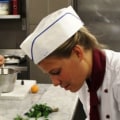Culinary Careers ~ Training and Career Information for Cooking Students. Private home cooks, sometimes called personal chefs, plan and prepare meals in private homes, according to the customer's tastes and dietary needs. They order food and supplies, clean the kitchen, and wash the dishes and utensils. They can also organize parties, Christmas meals, lunches and other social events.
Private home cooks usually work full time for one client, although many are self-employed or are employees of an agency, and regularly prepare meals for several clients. A chef is a professional person who prepares items for consumption in the food industry, especially in environments such as restaurants. A chef is sometimes referred to as a chef, although in the culinary world the terms are not interchangeable. The responsibilities of cooks include preparing food, managing food stations, cleaning the kitchen and helping chefs.
Restaurants will give chefs a degree according to their designated stations. Examples include grill cooks, fry cooks, pantry cooks, and sauce cooks. The culinary career is traditionally associated with cooking, however, chefs and cooks are not the only occupational path in the field. It is an increasingly diverse industry, with opportunities in both traditional ones (p.
ex. Hospitality is a growing industry that employs hundreds of thousands of people every year and is expected to continue to expand. The culinary arts are also flourishing as more people choose to eat out. Working in restaurants or in the food service industry requires a lot of hands-on experience, but earning a certificate or degree in Culinary Arts can expand your career options.
Either way, working in the kitchen is the goal. In each kitchen there are a number of different functions that make a kitchen work smoothly to deliver orders in a timely manner. In this blog, we review the possible career options available in a restaurant kitchen. The cooks who prepared and cooked food for members of the Chinese population who were in the upper echelons of society and could therefore afford it, operated through inns, restaurants and even wandering the streets like street vendors, thus offering customers a variety of options.
Despite the exclusive nature of work and the status levels of the people for whom they prepared food, the occupation of cooking during the Ming era was not a highly coveted profession because of the number of animals involved in being a cook. In the Middle Ages of Northern France (around the 9th-15th century), being a cook was a well-known profession in the community. Kitchen utensils are made with anything from wood, glass, various types of metals, to the newer silicone and plastic that can be seen in many kitchens today. Below is an overview of the possible occupational options available to individuals interested in pursuing a career in the culinary field.
People who work in this field, especially in establishments such as restaurants, are often referred to as chefs or cooks, although, in their most general form, the terms culinary artist and culinary artist are also used. Cooks use a variety of kitchen equipment, including roasters, grills, slicers, shredders and blenders. Anyone who enjoys cooking has probably thought about what it would be like to work as a high-level chef. Vocational cooking schools, professional culinary institutes, and some universities offer culinary programs for aspiring cooks.
Professional culinary institutes, industry associations and unions can sponsor such programs for cooks. The responsibilities of cooks vary depending on the type of food service establishment, the size of the facility and the level of service offered. To prepare high-quality meals at these locations, many managers and chefs will need experienced cooks. Chefs work in restaurants, schools, hospitals, hotels, and other establishments where food is prepared and served.
For chefs seeking promotion to higher-level chef positions, certification can show accomplishments and lead to higher-paying positions. The second at the command post supervises and guides kitchen staff and can help plan menus, cook meals or special meals. Cooks spend a lot of time standing in one place, cooking food on hot stoves and cleaning work areas. .
.


